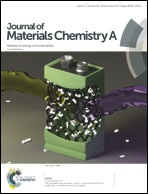Carbon coated bimetallic sulfide nanodots/carbon nanorod heterostructure enabling long-life lithium-ion batteries†
Abstract
Exploitation of high capacity and long-life anode materials is essential for the development of lithium-ion batteries (LIBs) with high energy density. Metal sulfides have shown great potential as anode materials for LIBs due to their high theoretical specific capacity and excellent electronic properties and therefore they are considered as excellent candidates for anode materials. However, structural degradation during cycling and polysulfide dissolution has limited their practical application. In this work, we design a unique 0D/1D heterostructure of carbon coated iron–nickel sulfide nanodots/carbon nanorod through simultaneous decomposition and sulfidation of a bi-metal organic framework template. The resultant nanodots/nanorod heterostructure allows for fast ion/electron transport kinetics, suppresses polysulfide dissolution and ensures structural integrity during the lithiation/delithiation process. Consequently, this carbon coated iron–nickel sulfide nanodots/carbon nanorod structure exhibits a high specific capacity (851.3 mA h g−1 at 0.5C after 200 cycles) and an excellent cycling stability (484.7 mA h g−1 after 1000 cycles at a high rate of 4C).



 Please wait while we load your content...
Please wait while we load your content...